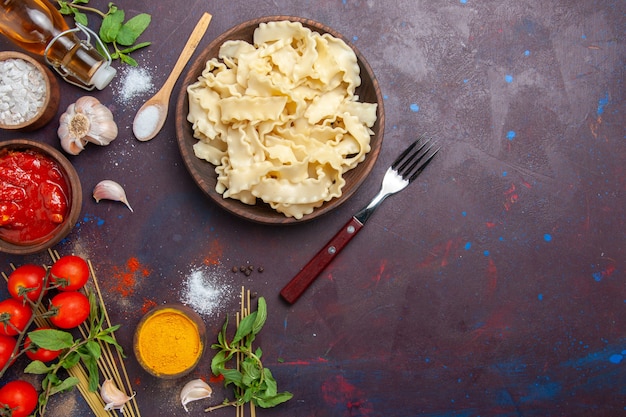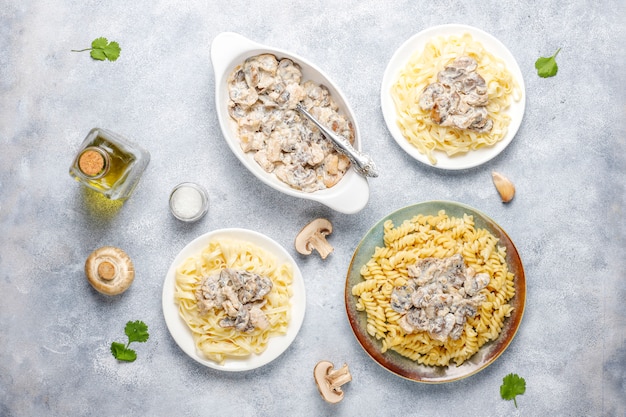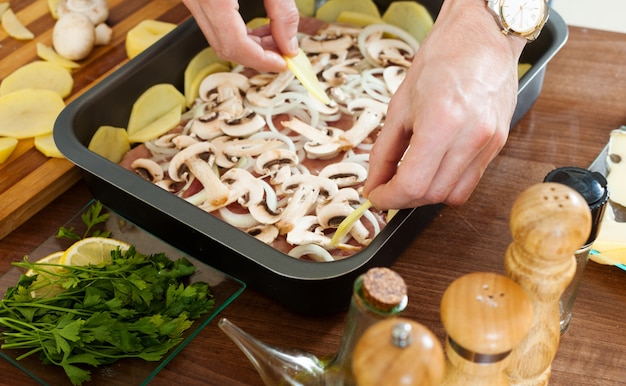Ah, Fettuccine Alfredo. Just the name evokes images of creamy, dreamy pasta, the perfect comfort food. But let's be honest, a good Alfredo isn't just about the sauce. It's about the chicken, too! A dry, overcooked piece of chicken can ruin even the most decadent sauce. That's why I've spent years perfecting my chicken technique for this classic dish, and I'm excited to share my secrets with you.
Part 1: The Chicken Choice: A Matter of Taste and Texture

When it comes to chicken, I'm a bit of a purist. I believe in using the best quality ingredients, and that starts with the chicken itself. So, let's break down the crucial decisions: breast or thigh? Bone-in or boneless? Fresh or frozen?
Breast vs. Thigh: A Tale of Two Chickens
Here's where I might ruffle some feathers. I'm a staunch advocate for chicken thighs, especially when it comes to Alfredo. They offer a naturally richer flavor and a juicier, more melt-in-your-mouth texture that elevates the entire dish. chicken breasts, while lean and healthy, can sometimes be a bit dry, especially in a creamy sauce.
Now, don't get me wrong, there's nothing wrong with chicken breast in Alfredo. If you're a breast enthusiast, I recommend pounding them to an even thickness to ensure even cooking and tenderness. However, if you're after that ultimate luxurious feel, thighs are your best bet.
Bone-in or Boneless: A Matter of Preference
This is really down to personal preference. bone-in chicken thighs, especially with the skin on, can lend a delightful richness to your sauce, almost like a stock. The skin releases its flavour as it cooks, adding depth and complexity to the dish. However, boneless, skinless thighs are definitely more convenient and easier to manage, especially for those who prefer less fuss. Ultimately, the choice is yours!
Fresh or Frozen: A Time-Saving Dilemma
While fresh chicken is always ideal, let's be real: life gets busy. If you're using frozen chicken for your Alfredo, make sure to thaw it thoroughly in the refrigerator overnight. This prevents uneven cooking and ensures the chicken is properly cooked. But if you're planning ahead, fresh chicken will give you the best results.
Part 2: Preparing the Chicken: Unleashing the Flavor

Now that we've chosen our chicken, it's time to bring out the flavor! Here's where a little bit of love and attention can make all the difference.
Marinate or Season: A Flavor Boost
I'm a firm believer in marinating my chicken, especially for Alfredo. It adds a layer of depth and richness that you can't get with simple seasoning. A simple marinade of garlic, olive oil, and lemon juice is a classic, but I often love to add herbs like thyme or rosemary for a more complex flavor. However, if you're short on time, don't worry! A generous seasoning of salt, pepper, and paprika can still deliver a delicious result.
The Importance of Salt: A Flavor Enhancer
Salt is not the enemy, people! In fact, it's your friend! Don't be afraid to season your chicken generously before cooking. Salt not only enhances the natural flavors but also helps the chicken cook more evenly, ensuring a juicier result.
Don't Overcrowd the Pan: A Recipe for Disaster
One of the biggest mistakes I've made over the years is overcrowding the pan. It's tempting to try and cook everything at once, but trust me, it's a recipe for disaster. Crowding the pan prevents the chicken from getting a good sear and can lead to steaming instead of browning. The result? A pale, bland, and possibly undercooked chicken. So, cook in batches if you have to, and ensure each piece gets that gorgeous golden crust.
Part 3: Cooking the Chicken: Mastering the Techniques

Now comes the fun part: cooking the chicken! While there are many methods, I've found three to be particularly effective for Alfredo.
Pan-Searing: For a Golden Crust and Rich Flavor
My go-to method for Alfredo is pan-searing. It produces that beautiful golden crust and locks in all those delicious juices. To pan-sear, heat a good amount of olive oil in a cast iron skillet over medium-high heat. Sear the chicken for about 3-4 minutes per side, until it's golden brown and slightly caramelized. You'll know it's ready when it easily releases from the pan.
Roasting: A Simple and Versatile Option
If you prefer a hands-off approach, roasting is a great alternative. Preheat your oven to 400°F (200°C). Season the chicken and place it on a baking sheet. Roast for about 20-25 minutes, or until the internal temperature reaches 165°F (74°C). This method is especially useful for cooking multiple pieces at once.
Grilling: A Smoky Flavor Boost
For a touch of smokiness, grilling is an excellent choice. Heat your grill to medium-high heat. Season the chicken and place it on the grill. Cook for about 4-5 minutes per side, or until it's cooked through and has nice grill marks. Just be sure to keep an eye on it, as grilling can sometimes be a bit unpredictable!
The Right Temperature: Safety First!
No matter how you choose to cook it, make sure your chicken reaches an internal temperature of 165°F (74°C). Use a meat thermometer to ensure it's cooked through. Overcooked chicken will be dry and tough, so aim for a slightly pink center. If you're concerned about food safety, err on the side of caution and cook it a little longer.
Rest It: The Secret to Juiciness
Once your chicken is cooked, don't rush to slice it. Let it rest for about 5-10 minutes before cutting. This allows the juices to redistribute, resulting in a juicier, more tender piece of chicken. This is a vital step, so don't skip it!
Part 4: The Sauce: Homemade vs. Store-Bought
Now we come to the heart of the dish: the alfredo sauce. Do you go homemade or store-bought? It's a personal decision, but I'll give you my honest take.
Homemade Alfredo: The Labor of Love
For me, there's nothing quite like the satisfaction of a homemade Alfredo sauce. It's a truly indulgent experience, and the flavor is unparalleled. The key is to use high-quality ingredients, such as freshly grated Parmesan cheese and heavy cream. And don't be afraid to experiment with your own flavor combinations. A little garlic, a splash of white wine, or even a pinch of nutmeg can take your sauce to the next level.
Here's a simple recipe for homemade Alfredo:
| Ingredient | Amount |
|---|---|
| Heavy cream | 1 cup |
| Freshly grated Parmesan cheese | 1/2 cup |
| Butter | 2 tablespoons |
| Garlic, minced | 2 cloves |
| Salt and pepper | To taste |
Melt the butter in a saucepan over medium heat. Add the garlic and cook for about 30 seconds, until fragrant. Pour in the heavy cream and bring to a simmer. Reduce the heat to low and whisk in the Parmesan cheese, a little at a time, until it's melted and the sauce is smooth. Season with salt and pepper to taste.
Store-Bought Alfredo: A Time-Saving Option
I understand that sometimes you just don't have the time or energy to make a homemade sauce. If you're going the store-bought route, choose a high-quality sauce made with real cream and Parmesan cheese. Avoid sauces that are overly thick or have a strong flavor, as they can overpower the chicken. Look for sauces that are made with simple ingredients and have a creamy, not overly cheesy, texture.
The Secret to a Creamy Sauce: Don't Overcook it!
Whether you're using homemade or store-bought sauce, the key is to not overcook it. Simmer it gently over low heat just until it's warmed through. Overcooked Alfredo will become thick and clumpy, losing its delicate creaminess.
Part 5: Assembling the Dish: Pasta Perfection
Now that we have our perfect chicken and creamy sauce, it's time to assemble the masterpiece.
The Fettuccine: A Starchy Partner
While you can use other pasta shapes for Alfredo, fettuccine is the classic choice. Its long, flat shape provides the perfect surface area for the sauce to cling to, creating that luscious, coated texture we all crave. When choosing fettuccine, opt for high-quality dried pasta. It should be firm and slightly rough to hold the creamy sauce. Avoid using fresh pasta, as it's too delicate for a rich sauce like Alfredo.
Cooking the Pasta: Al Dente is Key
Cook the pasta according to the package directions. Aim for al dente, meaning it should be cooked through but still have a slight bite. Don't overcook it! It's important to reserve a cup of the pasta water. This is your secret weapon for creating a perfectly silky, smooth sauce.
Bringing it All Together: The Final Touches
Now, for the moment of truth! Combine the cooked pasta with the Alfredo sauce, gently tossing it until it's evenly coated. Add your sliced chicken and a generous sprinkle of freshly grated Parmesan cheese. If the sauce seems a bit thick, add a little of that reserved pasta water. The key here is to be gentle; over-mixing the pasta can create a clumpy mess.
Part 6: Presentation is Key: Elevate the Dining Experience
Let's face it: even the most delicious dish can benefit from a little presentation magic. A beautifully plated meal enhances the dining experience and makes every bite a sensory delight.
The Plate: A Blank Canvas for Beauty
I prefer to use a white plate for Alfredo. It allows the vibrant colors of the dish to shine through. A slightly larger plate can also create a sense of abundance and make the dish look even more inviting.
The Garnish: A Touch of Elegance
A simple garnish can elevate the dish to new heights. A sprinkle of fresh parsley or a drizzle of olive oil adds a touch of elegance. You could also add a few cherry tomatoes, a sprinkle of red pepper flakes, or even a sprig of basil for a pop of color.
The Final Touch: Fresh Parmesan Love
Finally, grate a bit of fresh Parmesan cheese over the top. It's not just about flavor; it creates a beautiful visual effect that makes the dish look absolutely irresistible.
Part 7: Variations on a Classic: Expanding the Palette
Alfredo is a truly versatile dish, and you can easily adapt it to your own tastes. Here are a few ideas for adding a touch of creativity to your classic Alfredo.
Seafood Alfredo: A Coastal Delight
Swap the chicken for shrimp, scallops, or crab. The creamy sauce pairs perfectly with the delicate flavors of seafood. You can even add a touch of lemon zest or a sprinkle of fresh herbs for extra flavor.
Vegetable Alfredo: A Lighter Option
Add a variety of vegetables to your Alfredo for a lighter, more nutritious meal. Broccoli, spinach, asparagus, mushrooms, and zucchini are all great choices. Roast or sauté them before adding them to the pasta for a bit of extra flavor and texture.
Spicy Alfredo: A Fiery Kick
For those who like a little heat, add a pinch of red pepper flakes or a splash of hot sauce to your Alfredo. This simple addition can transform a classic dish into something truly exciting.
Truffle Alfredo: A Luxurious Indulgence
If you're feeling fancy, add a few shavings of black truffle to your Alfredo. The earthy aroma and intense flavor of truffle will elevate the dish to a whole new level of luxury. It's a touch of extravagance that's sure to impress.
Part 8: Serving Suggestions: The Perfect Accompaniments
Now that your Alfredo is ready to eat, let's talk about the perfect accompaniments.
Wine Pairings: Complementary Flavors
A dry white wine, like a Pinot Grigio or a Sauvignon Blanc, complements the creamy richness of the Alfredo sauce. The bright acidity of these wines cuts through the richness of the dish, creating a harmonious balance.
side dishes: A Touch of Balance
A simple side salad with a light vinaigrette is a perfect accompaniment to Alfredo. The fresh, crisp vegetables provide a refreshing contrast to the creamy pasta. For a heartier option, try a side of roasted vegetables, garlic bread, or even a light soup.
Dessert: Sweet Ending to a Savory Journey
A light and refreshing dessert, like a fruit salad or a sorbet, is a great way to finish off a meal with Alfredo. The sweetness of the dessert balances the richness of the pasta, leaving you feeling satisfied but not overly full.
Part 9: FAQs: Answers to Your Alfredo Questions
Still have questions about making the perfect Alfredo? Here are some answers to commonly asked questions.
Q1: Can I Make Alfredo Ahead of Time?
Yes, you can definitely make the Alfredo sauce ahead of time. It will keep well in the refrigerator for up to 3 days. However, I recommend cooking the chicken and pasta separately and then assembling the dish just before serving. This will ensure that the pasta stays al dente and the chicken remains tender and juicy.
Q2: What If I Don't Have Parmesan Cheese?
If you don't have Parmesan cheese, you can use another hard cheese, such as Pecorino Romano or Asiago. However, the flavor won't be quite the same. These cheeses have a sharper, more intense flavor than Parmesan, so you might need to adjust the amount you use.
Q3: Can I Use Different Pasta Shapes for Alfredo?
Absolutely! While fettuccine is the classic choice, you can use any type of pasta you like. Linguine, pappardelle, or even penne would work well. Just choose a pasta shape that can hold the creamy sauce and complements the other ingredients in your dish.
Q4: How Do I Store Leftover Alfredo?
Store leftover Alfredo in an airtight container in the refrigerator for up to 3 days. The sauce will thicken slightly as it cools, but you can add a little pasta water to thin it out before reheating.
Q5: Can I Freeze Alfredo?
While you can freeze Alfredo, it's not ideal. The sauce can separate and become watery when thawed. I recommend only freezing the sauce and not the pasta or chicken. To freeze the sauce, simply place it in a freezer-safe container and freeze for up to 3 months.
So, there you have it, my secrets to making the perfect chicken for a truly decadent Fettuccine Alfredo. Now go forth and create your own culinary masterpiece!
Everyone is watching

Corn on the Cob: The Ultimate Guide to Perfectly Cooked Ears
Healthy MealsAh, corn on the cob. Just the name evokes images of sunny days, barbecues, and that sweet, juicy flavour that ...

Perfect Pork Roast Oven Cooking Time: A Guide to Delicious Results
Healthy MealsThere's something truly satisfying about a perfectly roasted pork. The aroma alone is enough to make your mout...

Scallops: The Ultimate Guide to Perfect Cooking
Healthy MealsAh, scallops. Those delicate, sweet, and utterly delicious morsels of the sea. They hold a special place in my...

Ham Cooking Time: How Long to Bake, Smoke, or Boil a Delicious Ham
Healthy MealsAh, ham. It's a classic, isn't it? A real crowd-pleaser, especially around holidays. And when done right, it'...

Spaghetti Squash: The Ultimate Guide to Cooking and Serving
Healthy MealsRemember that time you saw spaghetti squash at the supermarket, looking all bumpy and strange, and thought, "W...
